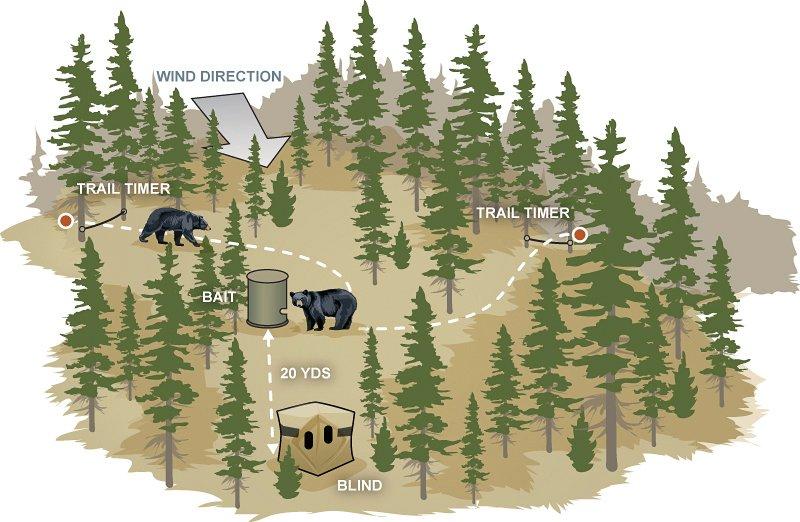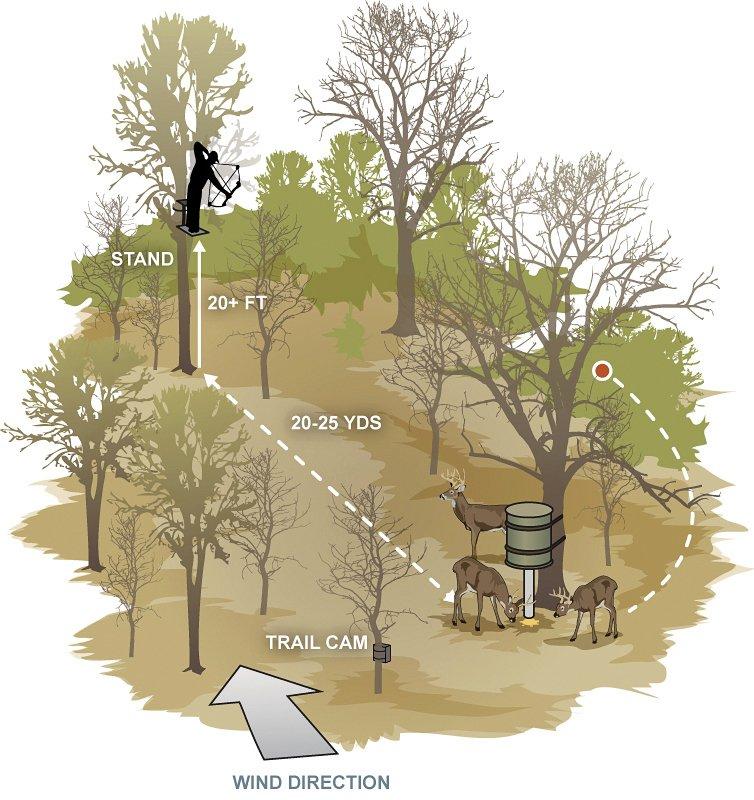Baiting Big Game
Thousands of hunters across North America rely on baiting for deer, black bears and hogs as a perfectly legal hunting practice. Detractors are quick to call baiting a lazy style of hunting, but that's simply not true.
Thing is, I've been a food-plotter since I was old enough to drive a tractor. I've killed dozens of deer and hogs over bait, too. I can honestly say that baiting takes just as much planning — and at times, more effort — than food-plotting. It can provide near immediate success when done correctly. But it's far from a guarantee.
This article isn't meant to stir the pot or cause a baiting debate. Instead, it's meant to detail a few proven bait setups that can up your odds for bagging a deer, hog or black bear. These setups are bowhunting-focused, but they'll work just fine for gun hunters, too.
HOGS
Veteran hog hunters know wild pigs are among the most intelligent animals in the woods. They can't see much — but they more than make up for that shortcoming with their sense of smell and problem-solving ability.
The Bait: Corn in a timed feeder
The Set: Without anchors, pigs will knock over and devour all the corn in a tripod feeder overnight. If you can't use a hanging feeder, drive rebar stakes a couple feet into the ground at an angle around each leg of a tripod feeder, and then secure the feeder legs to them with rope or wire.
Hogs with any inkling of hunting pressure will circle 40 yards or so downwind before committing to bait. But they'll also avoid wide-open fields in the daylight, preferring instead to skirt along the edges. Set your bait on the seam between a thick bedding area and field with your stand just downwind of the bait. The field should be at your back. Pigs that don't step right out and commit to the bait will often pass within bow range while circling to scent-check.
The Stand: Given a pig's poor eyesight, ladder stands set 15 yards from the bait will suffice, even with minimal cover.
Plot Watch: Evenings are prime, but unpressured hogs may hit a bait at any time of day. Set a PlotWatcher 15 yards off the bait to determine not only when they hit it, but also which direction they're coming from so that you can plan your hunt around a favorable wind.
Pig Facts: Pigs are lazy critters, and when they get comfortable at a bait site, they'll often homestead it, bedding down right under the feeder. Take your time and sneak into your set quietly — you may stick a pig long before climbing into your stand.
BLACK BEARS
Kristy Titus is a black bear hunting veteran. Although most of her hunting is spot-and-stalk, she's spent plenty of time creating bait sets for bears in Canada, too.
The Bait: Regulations vary widely on the types of baits that can be used for bears. Titus has the most experience with a blend of oats and cooking oil, which seems to work especially well during the early season. Rolled oats can be purchased at a feed store. Old cooking oil can be obtained for free from many restaurants.
The Set: Fill a 50-gallon drum full of the oats and oil mixture, and cut a small, horizontal hole at the base of the barrel so that the bears can get at the oats. If legal, meat scraps (beaver carcasses are choice) add an aroma that bears can detect from a long way. Titus says firing up a camp stove and frying a pound of bacon just upwind of the bait site the morning before you plan to hunt puts even more bear-attracting scent in the air. Everybody likes bacon. Bears included.
The Stand: Treestands work, but Titus likes ground blinds for pressured bruins. If you've baited a certain spot for multiple years, they'll get to where they circle 60 to 80 yards downwind of a bait and look up in the stand, she says. So I've had good luck by staying mobile with a blind set downwind of the bait.
Trail Timers: Titus says trail cameras can be a bad idea for bear baits. If you get the bait scent on a camera, they'll tear it to pieces, she says.
Many veteran bear guides instead opt for string-activated trail timers. At about $20 each, these still clue you in to the time of day bears are hitting your bait set, but you're not out a fortune if one of them smells enough like cooking oil for a bear to snack on it.
Bear Facts: Sows, cubs and young boars often hit baits early in the morning and even at midday. Big boars usually step out at dark. For that reason, most bear hunting over bait takes place in the evening. Unlike hogs or deer, bears will become quite acclimated to your scent around a bait station as well. Don't be surprised if a curious bear peaks inside your ground blind with you sitting in it.
WHITETAILS
Bait accounts for plenty of notched deer tags every fall. It's especially effective in big-woods country and on small parcels of ground where agricultural options for deer are limited. During the first few days of archery season, a good bait set can put bucks, big ones included, in your lap.
The Bait: Opinions on whitetail bait abound. In the Northeast, apples are a favorite. Down South, it's yella acorns, aka, shelled corn. Whatever the choice, providing deer with a taste of something out of the ordinary is the key. If you're surrounded by standing corn fields, a corn feeder in the woods won't do much good.
The Set: Using corn, I have more luck when deer can eat it at their leisure than I do with timed feeders. Corn scattered on the ground works great, but can get expensive. Simple gravity feeders do the job, save me a few bucks on corn, and can be built at home. Many hunters like to use PVC pipe under a barrel of corn, latched to a tree. Leave a gap between the pipe and the ground just wide enough for corn kernels to trickle out.
The Stand: The best time to kill a good buck over bait is unquestionably during early bow season, when they're on summer bachelor patterns. Unlike a large bean field or food plot, a bait set will put the bucks right where you need them for a shot. Don't set your stand too close, as you'll likely have does visit the bait before your bachelor group gets there. Hang a lock-on plenty high and well concealed, 20 to 25 yards away from the bait.
Trail Cameras: If ever there's a time to have a trail cam set right next to a feeder, it's during the early season. Check your camera frequently, and when your buck shows up in shooting light, hunt him as soon as the wind allows.
Whitetail Facts: Don't let anyone tell you a big buck is too smart to be killed over a corn pile. It's just not true, as several of our Rack Reports have proven over the years. That said, it's often a one-shot deal. If you spook him off the bait, the gig is usually up for the season.
Editor's note: This article was originally published in 2012.
Click here for more big game hunting articles, galleries and videos.
Follow us on Facebook.










